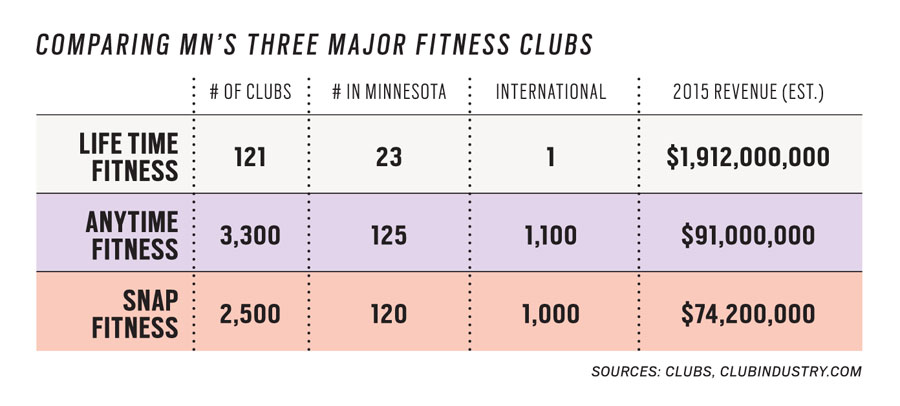
Anytime Fitness co-founders Chuck Runyon and Dave Mortensen
Photo by Ackerman + Gruber
An odd thought occurred to Emily Lofboom as she lay on a massage table for the first tattoo of her life: Didn’t I interview for my job in this room?
Employees at Anytime Fitness, the franchise health club company based in Woodbury, have a unique way of showing loyalty to the brand: getting tattoos of the company’s cartoon-y running-man logo.
Anytime co-founders Chuck Runyon and Dave Mortensen sport them, along with nearly 3,000 employees and club members worldwide. Enough employees follow their bosses’ lead that Anytime installed a full-service tattoo parlor in its new headquarters and has brought in celebrity tattoo artist Jimmy Hayden, whose clients include NBA star Lebron James, to do the inking.
If that sounds weird and a little cultish, you’re not alone. Initially, Lofboom, a vendor relations manager, resisted. “Not being a tattoo person, I thought, ‘this is just crazy,’” she says. “But I loved the passion for the brand, and I loved the culture here.”
Shortly after Lofboom started, Anytime hired her husband, Patrick, as a franchise consultant. The initially tattoo-averse couple soon embraced the ideals of a company devoted to wellness and decided to get inked.
Patrick went first (Emily was pregnant at the time) and then, about a year later, supported his wife while Hayden tattooed a running man on the inside of her left ankle. (This was when Anytime was still at its old headquarters in Hastings, so Hayden set up shop in the same small meeting room where, indeed, Emily had interviewed.) “My husband held my hand, and I almost broke it,” Emily recalls. “My body reacted very similar to when I was in labor. You want it so bad that it’s worth it in the end, but my God, when you’re going through it, it sucks.”
Now, when Emily works out, the running man pokes up from the top of her sock. She says she can’t ever see herself without it, even if she and the company part ways. “During the course of that year, we moved into our first house, adopted a dog, I got my position here at Anytime, we got pregnant with our first child, and Patrick got his position here at Anytime,” she says. “Because of that, it’s not like we just tattooed a logo on our body. It means so much more for us as people and as a family, and what this company has done for us and our lives. We can work hard at a place that has awesome, infectious passion, and we can help others with their fitness journeys as well, indirectly. I would never, ever regret it.”
Even though Minnesota always comes out near the top of national health and exercise rankings, its stature in the fitness industry—three of the largest health club chains in the country make their headquarters in the Twin Cities metro—is relatively unknown.
Life Time, the Chanhassen-based chain of upscale, sprawling health club/day spas is largest, ranking third on the fitness trade publication Club Industry’s Top 100 list (behind LA Fitness and 24 Hour Fitness), with an estimated $1.35 billion in annual revenue. Anytime, the world’s fastest-growing fitness franchise of small, no-frills facilities, ranked 16th, with nearly a billion in annual revenue. Just two places behind is LIFT Brands, the Chanhassen-based parent company of the Snap Fitness chain, with bare-bones clubs (many of the older ones don’t even have showers) and a franchise-based model similar to Anytime’s.
“We affectionately call Minnesota ‘Sweat Valley,’ like Silicon Valley out west,” says Anytime CEO Runyon, who grew up East St. Paul, not far from Mortensen, the company’s president, in St. Paul Park. “Not only do we have three of the major fitness brands, but quite a few of the manufacturers—probably more of both in this city than any other city in the country.”
A short list: Octane Fitness in Brooklyn Park makes elliptical trainers. Torque Fitness, based in Coon Rapids, sells varied exercise equipment. So does Illinois-based Life Fitness, which last year finished a major expansion of its Ramsey plant. Ditto Cybex, out of Massachusetts, which operates a second plant in Owatonna.
So how did Minnesota become such a breeding ground for the fitness industry?
“I tie it back to our heritage, our Scandinavian influence and how active they are in those regions of the world,” Runyon says. “I think it’s climate that encourages inside-the-club activity when the weather is really bad. And if you go back decades, Minnesota has been very progressive in terms of medical technology companies. We have a great culture of wellness here. It’s a confluence of heritage, climate, and progressive medical mindset that planted a seed.”

Snap Fitness CEO Peter Taunton
Photo by Ackerman + Gruber
It wasn’t that long ago when “gym” meant high school phys ed, without the “the” in front of it, or the dank, grungy haunts of bodybuilders and boxers. For exercise, people jogged (versus ran), kept a dusty weight bench or NordicTrack in the basement, dabbled at racquetball, or engaged in a little Sweatin’ to the Oldies.
Today, fitness is a global, multi-billion dollar business as “going to the gym” eased into the vernacular. The International Health, Racquet, and Sportclub Association (I.H.R.S.A.), a major trade organization, estimates health clubs worldwide generated $81 billion in revenue in 2015. About one-third of that came from the U.S., which accounts for an equal portion of the world’s 151 million club memberships. Sweat may not be beating the country’s obesity crisis, but it sells.
And yet, it’s a fast-changing market. What’s hot now may be passé in a year, and clubs slow to adapt risk failure or takeover. Remember the popular all-purpose clubs Bally Total Fitness and Nautilus Fitness Centers? Gone. Today, thousands of clubs specialize in yoga, pilates, zumba, kickboxing, CrossFit, or something else.
“It’s an industry that has been growing, but has been fragmenting faster than it’s been growing,” says Life Time’s founder and CEO Bahram Akradi. The company has its niche well defined: massive clubs and diverse offerings, catering to the affluent (Life Time claims a $120,700 median income for its 1.8 million members).
Life Time’s downtown Minneapolis locations in particular draw an elite crowd from the legal and business communities whose workouts are as competitive as their careers. And dealings that once took place on the golf course are shifting to Yoga Sculpt or Spin class. There’s a certain see-and-be-seen vibe to the clubs: Until recently, Life Time’s Target Center location housed the Timberwolves’ curtain-shrouded practice courts, and its Grand Hotel fitness center has attracted pro athletes and their entourages from the guest rooms—including the actress Kate Hudson, once spotted working out in sunglasses when her then-beau Alex Rodriguez was in town with the Yankees.
The average Life Time club costs $50 million to build, covers 100,000 square feet—the scale of the rec center at a mid-size private university—and employs 300. About a fifth of its 121 U.S. clubs (there’s one in Toronto) are in Minnesota, the most of any state. Most include cardiovascular and weight lifting equipment, basketball, tennis and racquetball courts, fitness classes, along with indoor and/or outdoor pools. But it’s really the amenities that distinguish Life Time from other gyms: the large locker rooms with whirlpools, saunas, and free towels, the child care center, the accompanying spa and café.
Ambitious projects fit the strong-willed Akradi, who seems to do everything on a grand scale and his own terms, often pairing black cowboy boots with his suits. His expansive office in the company’s three-story Chanhassen headquarters, just down the road from Paisley Park, is large enough to host a dinner party. Though Akradi accepted a $4 billion offer from three private equity firms last year, taking Life Time private, he remains the company’s CEO. And at 55, he prefers high-intensity training and obstacle racing to a mellow bike ride—exactly what you would expect from a man who takes his tea in an enormous Starbucks coffee cup.
“Think big or go home, right?” he says with a wry smile.
Akradi grew up in Iran, the son of an Iranian military officer. As a teenager Akradi idolized his older brother, who flew F-4s in the Iranian Air Force, and dreamed of joining him in the skies. But this was 1978, the year before the overthrow of the Shah. Akradi’s father sent him to the U.S. to study
electrical engineering.
“My dad did not want me to stay in Iran,” Akradi says. “It was partially a hunch things were not going to be smooth sailing—and partially because I really wanted to join the Air Force, and he didn’t want a second kid in the air to worry about. So he diverted me to engineering school.”
While an undergraduate, Akradi earned extra money selling memberships at a local Nautilus and swiftly moved up into management. Shortly before graduation, an offer to co-manage a new club lured Akradi from Colorado to Minnesota. After a period as an executive, he left to start Life Time in 1992—realizing his vision for a chain of all-encompassing clubs promoting a healthy, holistic lifestyle that today even extends to its own series of triathlon races and a fitness and wellness magazine, Experience Life, with a circulation of some 700,000.
“We don’t consider any fitness center as our competition, although they do one of the 30 or 40 things that we do,” Akradi says. “We don’t have anyone in the country doing anything as big or as broad as we’re doing, because it’s really, really complex by design.”
Anytime and Snap, which launched in 2002 and 2003, respectively, are budget-friendly alternatives to Life Time, offering memberships for as low as $35 a month. The small, spare facilities (Anytime’s average 5,000 square feet; Snap’s are similar or slightly smaller) offer 24-hour access, but are only staffed part-time. “You’re not putting on makeup to work out at Anytime Fitness,” co-founder Chuck Runyon explains.
That Snap came along one year after Anytime with essentially the same concept irritated Runyon, who told Forbes that his competitor’s founder, Peter Taunton, “has done a good job copying us.” Taunton concedes the products are “very, very, similar.” Yet it’s worth noting that both concepts resemble more compact versions of 24-Hour Fitness, which launched in 1983 and has no clubs in Minnesota.
Anytime expanded quickly to some 3,300 franchises. And last June, Entrepreneur Magazine named Anytime its top global franchise for the second consecutive year, based on system size, growth, and financial stability.
Runyon and Mortensen never imagined an enterprise this massive when they started out in the 1990s managing a few small clubs in outstate Minnesota, areas they felt were underserved by the industry. Runyon’s interest in health and fitness began with family; his older brother was born with a heart defect and died at 18, though Runyon said it never slowed him down. “I don’t take health for granted,” Runyon notes. “Every single day, I get to come to work and help people enrich their lives, whether through better health or franchise ownership.”
Last year, Anytime moved its corporate headquarters to a vast woodland site in Woodbury, about a mile down Weir Drive from the McDonald’s where Runyon flipped burgers and shook French fries as a teenager. (His mother was a manager there.)
The massive, two-story complex is clad with Kasota limestone (like Target Field) and includes a large communal lunch area and fully equipped fitness club. The building is surrounded by an outdoor patio with fire pits and a running path—and a zip line is being installed.
All these amenities express the company’s core values, which are prominently displayed: People, Purpose, Profit, Play. “That’s our philosophical lens,” Runyon says. “If you’re surrounded by great people, if you know that what you do changes the world, if you can profit from it and you can have fun every day at work, it’s like the Holy Grail. I think I’ve found the secret to life.”

Of Minnesota’s fitness club CEOs, Taunton appears the least enamored with corporate trappings. He brings his Chihuahua to work every day at the LIFT Brands (Snap Fitness’s parent company) corporate offices in Chanhassen, about a mile and a half from Life Time’s headquarters.
Taunton learned business from the ground up. His father ran a grocery store in Willmar, and Taunton started out as a 10-year-old selling popcorn in front of the store. He moved up to tackle different jobs, from bag boy to stocking produce. “He was never one to give an allowance, but he always gave you an opportunity to work,” Taunton says of his dad, now 85 and ranching in South Dakota.
A former racquetball player on the North American pro tour, Taunton took over a failing club in his hometown, made it profitable, then built a portfolio of seven large, all-inclusive clubs. He eventually sold them all. He then decided to build a smaller one in Hastings, minus the pool, aerobics studio, and other amenities, launching the concept of Snap. “I knew Snap Fitness wouldn’t appeal to 100 percent of the audience, but I knew for 75 percent of the population, my product would resonate with them,” Taunton says. “If you need child care, swimming pool, basketball courts, a spa, I’m not your answer, and I have to be OK with that.”
The concept is doing more than OK, challenging Anytime with some 2,500 clubs. And that’s even with Taunton funding his competition, maintaining a Life Time membership so his wife can take fitness classes.
The fitness industry shares similarities with the self-help movement: People physically change themselves. Not surprisingly, it cultivates charismatic leaders who view fitness as a way of life and pair visionary thinking with an athlete’s discipline and determination.
Each of Minnesota’s major fitness club CEOs is self-made and driven. (Akradi’s intensity spills beyond his business and, more than the others, has brought him into the public eye, including a 2007 altercation with a student in the parking lot of his daughter’s high school.) And each seeks to evolve and remain relevant in an industry where tastes change faster than the seasons, with new concepts getting up and running as often as others drop out of the race.
Taunton seeks to capitalize on the industry’s main source of recent growth, boutique fitness clubs. Two years ago he created LIFT Brands by taking a $200 million investment from a private equity firm and purchasing interests in yoga, kick-boxing, and personal training firms. (Snap and Anytime also both see on-demand personal training as the next big thing, and each is trying to get a foothold.) Sport-specific studios are white-hot right now, most famously the physically and emotionally intense SoulCycle, a celebrity favorite that one socialite described to Vanity Fair as “the Valentino of exercise.” And the boutique fad is unlikely to fade considering Millennials’ interest in workouts where they can develop relationships with instructors along with a connection to a brand.
While Taunton is going niche, Akradi is expanding Life Time’s already broad view of fitness into all-encompassing, health-focused living. For example: plans for a 130,000-square-foot Life Time complex pairing 300 apartments and office space with the club—basically, everything one needs to work, live, and stay fit, including health care and a pharmacy, in one location. “In the future, fitness is going to be a challenging space in the United States,” Akradi says. “Very saturated. Very tired. It will continue to have companies treading water in terms of what they can do. However, the category that we’re in—healthy living, healthy aging, healthy entertainment—the next half-a-dozen years will be really, really fun for our company and the expansion of our brand. We’re a $1.5 billion company that probably could be $2 billion to $3 billion in the next five to seven years with all the expansion we’ve got coming.”
If Life Time hopes to immerse a select group deeply into its brand, Anytime’s goal is to get its clubs in front of as many people as possible. Runyon and Mortensen envision their Minnesota-based company becoming a household name across the globe, with running-man tattoos peeking out from under desert robes and parkas alike. “We’re very ambitions guys,” Runyon says. “This year, worldwide growth will outpace domestic growth. We’ll sell and open more studios internationally than we will domestically. That’s probably now going to be a trend for many years to come. We will be in Africa soon—Cape Town—it’s in the works. Maybe Morocco. We’re going to find a way to get to Antarctica, darn it. We know people who work on a research base, and we’re going to donate the facility and equipment to one of the bases.”
Online extra photos of the Anytime Fitness headquarters

Running path at the Anytime Fitness headquarters
Photo courtesy of Anytime Fitness

The tattoo parlor at Anytime Fitness
Photo by Jeremy Nelson

Photo courtesy of Anytime Fitness







